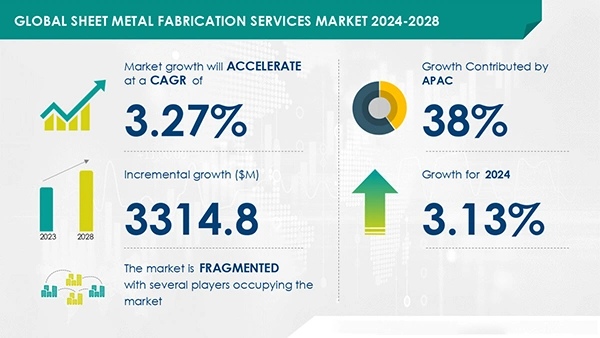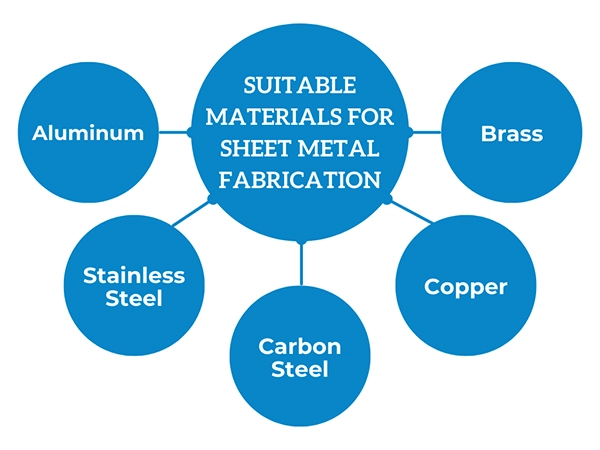
Sheet metal fabrication is an interesting and essential operation in the sphere of industrial and construction projects.
The process of converting flat sheet metals into different forms and structures through cutting, bending, and assembling is what fabricates sheet metals.
This complex art is fundamental in the production of various goods such as electrical gadgets, construction pipes, and machinery that we come across every day.
Moreover, a recent industrial report outlines that the Sheet metal fabrication market globally will register the highest growth in the years to come.
It became possible due to the adoption of technology and the increase in the demand for sheet metal processing services such as automotive, manufacturing, aerospace, and construction.
Hence, Sheet metal fabrication is indeed a complex process, and if you have just stepped into this industry, it’s very pivotal that you first understand the basics of this process.
This guide will be your great assistance as it has broken down the key steps, materials, techniques, and applications involved in this manufacturing process.
Sheet metal fabrication is a method that consists of reducing any raw material into multiple structures by performing operations like cutting, bending, and welding.
It begins with choosing a relevant metal sheet, followed by a stage where the chosen metal sheet is cut accurately by using laser or water jet cutting.
The next phase entails the deformation of the sheet metal by a press brake or rolling machine.
In the last step, the product is completed with the final assembly with all parts using ‘bodyworking’ methods like MIG, TIG, or spot welding as appropriate to the task.
Thus, the technological growth within the industry and commitment to upholding the environment have changed.

In the industrial market, you can easily find a plethora of metals, however, choosing the one with distinct properties and advantages is what takes you toward the path of success.
However, as you are a newbie, you may start with the common yet pivotal metal materials used in sheet metal fabrications:

Before you go into the experiment with them, first must understand the specific traits and ideal applications of each metal alloy.
Sheet metal fabrication is a complex activity in which possibly flat panels of metals are turned into different forms, in a logical flow within a number of prominent steps.
Each of these steps is very pivotal in forming the end product and the accuracy and quality of the fabricating done is guaranteed.
The only thing one can add in this context is that Sheet Metal Fabrication is an accurate and thorough preparation of each operation from cutting and shaping to the assembly and finishing, within strict guidelines for the metal structures produced as ordered.
It always depends on the specific project requirement, each part goes through a single or several different techniques to achieve the final product.
Go through this section, and familiarize yourself with some of the common sheet metal fabrication techniques listed below.
Punching and stamping is a technique used to bore holes into sheet metal and can be done in different shapes depending on what design has been demanded.
In this list of various types of shearing techniques, Guillotine Shearing is the most commonly used in sheet metal fabrication for trimming and removing unwanted materials.
Deep drawing is a technique that involves creating a three-dimensional shape such as a vessel, chamber, or dome, from a flat sheet of metal by pulling it into a forming die using a punch.
Welding is another common technique used in the manufacturing industry for joining metals.
In this, the two pieces of sheet metal are heated up to the melting point, then the torch is used to weld them together.
The process is commonly found on aircraft, cars, trucks, appliances, boats, ships, and other industrial equipment.
Sheet metal fabrication is a demanding component of many industries, from aerospace and automotive to construction and electronics.
In this section, we’ll explore some of the practical applications of this manufacturing process:
Thus, the process is a great approach for manufacturing body panels, frames, and engine components.
If there is any form of manufacturing that is in high demand in major industries, Sheet metal fabrication seems to fall into such categories.
The following are some key advantages of sheet metal fabrication that make it so appealing for different product applications:
Further, as technologies develop, sheet metal works such as laser cutting and CNC bendings turn more cost-effective and more effective, labor cost comes down and production volume also increases.
In summary, sheet metal fabrication comes with these or other additional advantages also presented.
Creation of metal parts and surfaces –this is the definition of sheet metal fabrication as one can look at it.
That description is however too shallow because the art of fabrication brings beauty in all of us.
Thanks to these works one can appreciate architecture, machines, and many more.
Over the years to come, what was thought impossible in sheet metal fabrication will be attainable steered by the developments in technology which are most welcomed. Also, learn about What Is PCB Cloning and How Does It Work by reading this article.
Thanks for choosing to leave a comment. Please keep in mind that all comments are moderated according to our comment Policy.